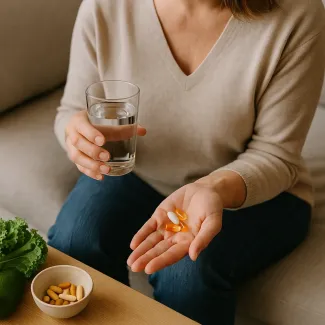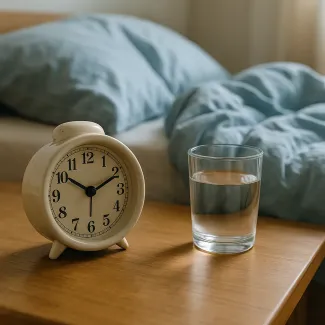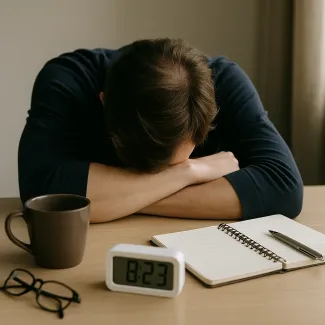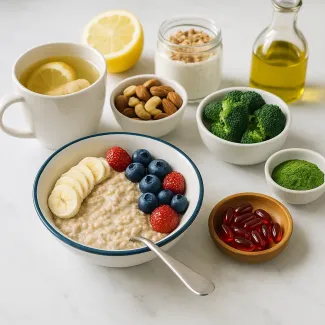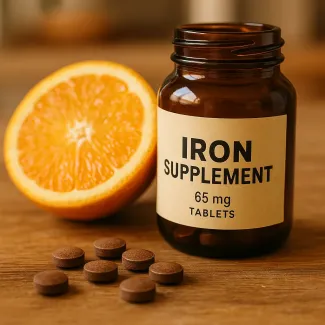
Choosing the right iron for anemia: types, timing, and tips for better absorption
What to know before starting iron supplements for low blood levels
Iron deficiency anemia is one of the most common nutritional problems in the world, yet it’s also one of the most misunderstood. Many people are told they need to take iron supplements, but few receive clear guidance on what type, how much, when to take it, or how to minimize side effects. This article unpacks the different types of iron supplementation, how they work, and how to support your body’s natural ability to rebuild healthy red blood cells.
While food sources of iron are important, supplements often become necessary when iron levels fall too low to be corrected by diet alone. But not all iron is created equal — the type, form, dose, and timing of supplementation all affect how well your body absorbs and uses it.
The role of iron in your body
Iron is an essential mineral that plays a critical role in oxygen transport, energy production, and immune function. Most of the iron in your body is found in hemoglobin — the protein in red blood cells that carries oxygen from your lungs to your tissues. When iron levels are too low, your body cannot produce enough healthy red blood cells, leading to symptoms like fatigue, shortness of breath, pale skin, and poor concentration.
In addition to its role in blood health, iron supports enzyme systems, helps regulate metabolism, and contributes to neurological function. For women of reproductive age, people with chronic health conditions, vegetarians, and those with poor digestion, getting adequate iron is particularly important.
Symptoms of iron deficiency you shouldn't ignore
Iron deficiency doesn’t always show up with obvious signs at first, but as your iron stores continue to fall, you may begin to notice persistent tiredness, weakness, headaches, dizziness, or even cold hands and feet. In more advanced stages, symptoms can include brittle nails, hair loss, rapid heartbeat, and difficulty concentrating.
If you’ve experienced any of the above symptoms consistently, it may be worth discussing iron testing with your healthcare provider — especially if you fall into one of the higher-risk groups for deficiency.
Who is at higher risk of iron deficiency?
There are several groups of people who are more likely to develop iron deficiency due to higher iron requirements, increased losses, or impaired absorption. These include:
- Women with heavy menstrual bleeding
- Pregnant and postpartum women
- Frequent blood donors
- Vegetarians and vegans
- People with digestive conditions like celiac disease or inflammatory bowel disease
- Athletes, especially endurance runners
Understanding your risk level can help guide your decisions about supplement use and dietary changes.
Types of iron supplements and how they differ
Iron supplements come in different chemical forms, and each type has its own profile in terms of absorption, digestive tolerance, and effectiveness. Here's a breakdown of the most commonly available options:
Ferrous sulfate
This is the most commonly prescribed iron supplement and typically contains around 65 mg of elemental iron per 325 mg tablet. It’s widely available and inexpensive, but often causes constipation, nausea, and abdominal discomfort in some people.
Ferrous gluconate
Containing around 35 mg of elemental iron per 300 mg tablet, this form is gentler on the stomach compared to ferrous sulfate. It may be a better option for those who struggle with gastrointestinal side effects.
Ferrous fumarate
This version offers a higher iron concentration, with about 106 mg of elemental iron per 325 mg tablet. It’s used for more severe deficiencies but may have similar side effects to ferrous sulfate.
Heme iron polypeptide
Derived from animal sources, heme iron is the most easily absorbed form of iron. It bypasses some of the digestive processes that limit absorption in non-heme forms, making it ideal for those with digestive issues or inflammation.
Iron bisglycinate (chelated iron)
A newer, more bioavailable form of iron that is bound to amino acids, allowing for better absorption and fewer side effects. Many over-the-counter supplements use this form because of its high tolerance and gentle action on the digestive tract.
How much iron do you need per day?
Daily iron needs vary based on age, sex, and life stage. Women between 19 and 50 typically require more iron than men due to menstrual losses. Pregnancy increases iron demands even further. Here's a general guideline:
- Men (19–50 years): 8 mg/day
- Women (19–50 years): 18 mg/day
- Pregnant women: 27 mg/day
- Postmenopausal women: 8 mg/day
It’s important to note that only a fraction of iron from supplements is absorbed. This means that the elemental iron content of a supplement — not the total pill size — is what matters most.
When and how to take iron for best absorption
Iron is absorbed in the upper small intestine, and certain factors can either enhance or inhibit its absorption. To get the most out of your supplement:
- Take iron on an empty stomach (unless it causes nausea)
- Pair it with vitamin C (orange juice, bell peppers, strawberries)
- Avoid taking iron with coffee, tea, dairy, or calcium supplements
- Wait at least 2 hours before or after taking antacids or other minerals (like magnesium or zinc)
Iron is best absorbed in smaller doses, spread throughout the day. For those with digestive sensitivity, taking iron every other day may actually improve long-term absorption.
What to do if you experience side effects
Common side effects of iron supplements include constipation, dark stools, nausea, and stomach pain. Here’s how to manage them:
- Switch to a lower dose or a more gentle formulation like bisglycinate
- Try slow-release capsules, though they may absorb less effectively
- Increase fiber and water intake to help with constipation
- Take iron with a small amount of food if you can't tolerate it on an empty stomach
If you continue to have issues despite adjusting the form and timing, speak with your healthcare provider about alternative options like intravenous iron therapy.
Combining iron with other supplements: what helps and what hurts
While some nutrients enhance iron absorption, others can interfere with it. Here’s what you need to know about common combinations:
- Vitamin C significantly boosts iron uptake — take it together.
- Calcium, zinc, and magnesium can compete with iron for absorption — space them out.
- Copper supports the metabolism of iron and hemoglobin production — consider a multivitamin with balanced trace minerals.
- B-complex vitamins, especially B12 and folate, are often co-deficient in anemia and can enhance red blood cell production.
Always read labels and avoid taking multiple high-dose minerals at once unless directed.
Can iron supplements cause too much iron?
Yes — iron overload is a real concern, especially in people who take supplements without a diagnosed deficiency. This condition can damage organs, increase oxidative stress, and raise the risk of infections.
Groups at higher risk of iron overload include:
- People with hemochromatosis (genetic iron storage disorder)
- Men who supplement excessively without testing
- Postmenopausal women who no longer have iron loss through menstruation
It’s always best to confirm iron status with blood tests like ferritin, hemoglobin, and transferrin saturation before starting long-term supplementation.
Iron supplements for different age groups
Your iron needs change throughout life. Here’s what to consider at each stage:
Ages 30–39
Many women in this age group begin to experience heavier or irregular menstrual cycles, increasing the risk of iron loss. Energy demands from career, family, and fitness also elevate the importance of maintaining adequate iron stores.
Ages 40–49
This is often a transitional phase hormonally, with perimenopause causing fluctuations that can affect bleeding patterns and nutrient metabolism. Iron deficiency can become more subtle — manifesting as brain fog, mild fatigue, or exercise intolerance.
Ages 50–59
Postmenopausal women usually have lower iron requirements. However, digestive absorption issues may begin to develop. Look for signs like low ferritin despite normal hemoglobin, which suggests a storage deficit.
Ages 60+
Older adults are at risk of anemia of chronic disease, often linked to inflammation, kidney function decline, or nutrient malabsorption. Gentle, highly absorbable forms like heme iron or iron bisglycinate are recommended, often in conjunction with B12 and folate.
Plant-based diets and iron supplementation
Vegetarians and vegans often rely on non-heme iron, which is less efficiently absorbed than heme iron from animal products. Factors that inhibit absorption in plant-based diets include phytates, calcium, and polyphenols. To boost absorption:
- Eat iron-rich plant foods (lentils, tofu, quinoa, pumpkin seeds) with vitamin C-rich foods
- Avoid tea and coffee around meals
- Consider chelated iron supplements or liposomal iron for higher bioavailability
If you follow a plant-based diet and experience chronic fatigue or reduced stamina, check your iron status regularly.
How long should you take iron supplements?
Correcting iron deficiency is a gradual process. Most people require 8 to 12 weeks of daily supplementation to improve hemoglobin levels and up to 6 months to fully replenish iron stores. Even after symptoms improve, it's important to continue supplements for several weeks to prevent relapse.
Always recheck iron levels to avoid prolonged use if not needed. Unnecessary supplementation can lead to toxicity or gastrointestinal discomfort.
Key signs your iron supplement is working
Some of the early improvements people notice within the first few weeks of supplementation include:
- Increased energy
- Better concentration
- Improved skin tone
- Fewer headaches
- More restful sleep
Within two to three months, hemoglobin levels should normalize, and symptoms like dizziness or cold intolerance usually subside.
The importance of personalized iron plans
No single approach works for everyone. The type, dose, and duration of iron supplementation should always reflect your specific needs, lifestyle, and any co-existing health conditions. Working with a healthcare professional ensures you’re addressing not just the symptom — anemia — but the root cause of your iron deficiency.
Pay attention to your body’s signals, and monitor progress. With the right approach, iron supplementation can become a powerful tool for restoring energy, resilience, and overall well-being.
